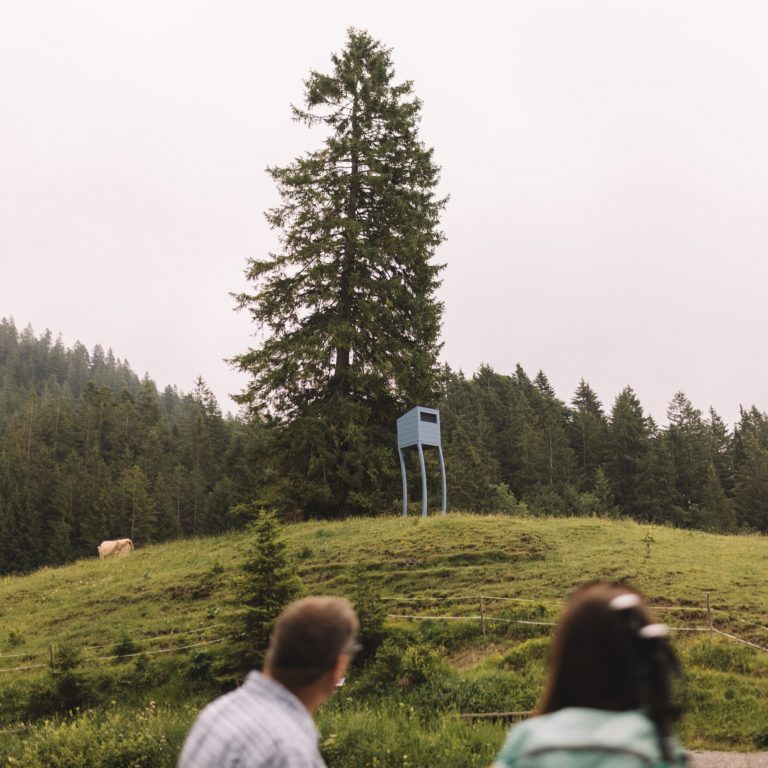
C Alpine Art - Feiger Hochstand Marbod Fritsch © Kirstin Tödtling / Vorarlberg Tourismus

C Alpine Art - Feiger Hochstand Marbod Fritsch © Kirstin Tödtling / Vorarlberg Tourismus
From the Alpine Art hiking trail to the Single Trail: worlds that would otherwise have little in common with each other meet on the Muttersberg. And, because up there, at 1,401 metres, the world is wide and perspectives open up all by themselves, everything has its place: sports, culture and enjoyment.
TEXT: CARMEN JURKOVIC-BURTSCHER
We’re holding our tickets and are ready to pass through the turnstile to the Muttersberg cable car. It’s nine o’clock in the morning. It’s a good time because the cable car is just beginning to run and we’ve got a car all to ourselves. Bludenz grows smaller in the distance below us as we float towards our destination: the Alpine Art hiking trail on the Muttersberg.
From the mountain station, which we reach just a few minutes later, it would only be a few steps to the Muttersberg’s alpine inn. But we’re meeting someone and refreshments must wait. Wolfgang Maurer, Chairman of the Verein allerArt art society in Bludenz, is already waiting for us. He’s going to be giving us the tour today and we’re excited to hear what he has to say about this art venue in the great outdoors.
Culture right at the heart of the countryside
The idea for the art trail came about as part of an EU LEADER project for the Bludenz Alpine Region, Wolfgang says, as we turn left from the mountain station to follow the gently sloping path into a pleasantly shady forest. “As part of this project,” Wolfgang continues, “old hiking trails were rehabilitated. And that’s when we came up with the idea to seize the opportunity and create an art trail.”The allerArt Society in Bludenz was commissioned to curate it. So, in 2018, we consequently joined forces with the operators of the Muttersberg cable car, the municipality of Nüziders and the city of Bludenz to realise a one-hour circular trail with six positions, designed by seven renowned artists whose roots originate in Vorarlberg.
We follow the signpost towards Fraßenhütte and Tiefenseesattel and turn left again at the fork. A magnificently meadow landscape in bloom opens up in front of us. There’s a lot of activity here, which is accompanied by chirping, buzzing and humming in all pitches, and we’ve already reached the first position, directly at the ascent to Hoher Fraßen. We’re standing in front of a heap of stones with blue-and-white markings that look as if they’ve been randomly piled on top of each other. A signpost rises from its centre that points in different directions without anything written on it. ”This piece is by Maria Anwander and is entitled ‘Komprimierter Weg’ (‘Compromised Route’),” Wolfgang says. Where do those signposts that we often seem to follow so blindly actually point? Is this the right way? And where are we going anyway? It’s questions like these that ‘Komprimierter Weg’ wants people to ask themselves.
We don’t need a signpost to reach the second position on the Muttersberg’s Alpine Art Trail because we’re already able to see it: a sky-blue raised hide just in front of a large dark green conifer. Its stooped uprights create the impression that it’s just about to sneak off. “That’s the ‘Feiger Hochstand’ by Marbod Frisch,” says Wolfgang. The ‘Cowardly Raised Hide’ is probably the most striking of the six works of art because it can be understood in many different ways. One way of looking at it, for instance, makes reference to hunting and how such a raised hide allows hunters to kill animals from concealment instead of in the face of nature. But the exciting thing, says Wolfgang, is that it also triggers completely different interpretations and vibrant discussions depending on the current social and political context.
A glimpse of paradise
We soak up the countryside around us as we continue along the service road towards Tiefenseesattel. It’s amazing how close you are here to Bludenz and yet how much you feel like you’re far away from everything that has anything to do with everyday life. Only lush forests, vast meadows and majestic peaks all around. We do not yet suspect that with these thoughts in our minds we’re already closing in on the next work of art: the ‘Blickbank’ (‘Viewing Bench’) by Monika Grabuschnigg, a simple concrete bench featuring an embossed pattern of checks and edelweiss on the left edge of the trail. “The bench was originally covered in blue and white tiles with edelweiss flowers,” Wolfgang says. But the tiles unfortunately had to be taken away because they weren’t weather resistant. The removal, however, doesn’t detract in the slightest from the intention of this position. This work of art was inspired by a passage from the ‘Die Wand’ (‘The Wall’), a novel by Marlen Haushofer.
A paradise could only exist beyond the bounds of nature and I am unable to imagine such a paradise.
It’s an excellent place to reflect on this thought even with today’s rather cloudy view of the Rätikon. We actually do so and not only find that we’re in agreement, but also discover that we’re this close to paradise today – clouds or no.
We allow ourselves a few minutes, then we walk down the narrow path, which branches off directly opposite the service road, straight towards the next work of art: a huge red sledge. It hangs there as if caught in time. Half in the air, captured in a moment of a straight descent that seems much too fast and that makes it appear as if it’s just about to topple over. “The size and intense colour gives Liddy Scheffknecht’s ‘Schlitten’ a pop-like character. Nevertheless, this position provides an idea of how arduous and risky work must have been for the alpine farmers here on the Muttersberg in the past,” says Wolfgang poignantly.
Following our noses
We continue on to the art trail’s next stage and we’re glad that we decided to wear sturdy shoes because it follows a narrow dirt track dotted with stones and roots back towards the Muttersberg cable car’s mountain station. Focusing on our footing, we hike for a while lost in our thoughts that are revolving around what we have seen so far and would so probably have walked straight past the next position if we hadn’t had a guide with us. But when Wolfgang stops, we see it too, the small grey sign pointing to the penultimate station on the art trail: the ‘Köpfegesellschaft’. This gathering of grey heads, hands and other body parts made from cement and gravel seem almost to melt into the surroundings. “This position is by Alfred Graf,” says Wolfgang, “who curated the Art Trail with Marbod Fritsch and me.”The proximity to the rock face on this part of the trail inspired the artist to have the people who have lived here on the Muttersberg over the years, decades and centuries gather at this spot. “If you don’t make a sound, you can hear them telling their stories,” Wolfgang says, smiling softly. And we listen, spellbound.
Downhill will eventually become uphill again. The dirt trail ends in a service road that takes us directly to the mountain station above. The prospect of a cool drink at the alpine inn gives us fresh momentum and makes the moderate climb feel a little easier. The last position also still awaits us!
The sixth work of art is to be found just before you get to the mountain station. A twisting fish with its mouth wide open rests here on a concrete block. The pedestal reads: “Blind faith in the endlessness of resources.” A fascinating while disturbing sight. A fish so far from the water leaves little doubt about its fate. “This position is by brothers Christoph and Markus Getzner. Their work frequently addresses how we humans are destroying our own livelihoods through greed and carelessness,” we learn. Something that couldn’t be more topical.
Refreshments and return to the valley
We reach the mountain station and thus the Muttersberg alpine inn a few minutes later. And, although it’s busier there than before, we’re quickly able to find a free seat on the spacious terrace. While we’re still thinking about what we’d like to drink, Rebecca Marte and one of her clients join us. The two plan to take their bikes down the Single Trail on the Muttersberg today. Rebecca is familiar with the route and is thrilled: “This trail really has everything. And she should know, after all, the 33-year-old is a full-time mountain-bike guide who works all over the country. While the start initially takes cyclists over forest ground, you soon have to dig deep: stony ground, hairpin bends and ledges demand skill and concentration. “This is the place to be if you’re into the technical side of mountain biking,” Rebecca says happily. She even knows cyclists who come all the way from Germany to use the trail on the Muttersberg to prepare for the Enduro World Series. Leaving the excellently developed trail is out of the question for the two women: respecting the limits of nature, the habitats and, of course, the other guests on the mountain goes without saying for Rebecca and her clients.
We chat a bit more and then slowly but surely make our way down to the valley – Rebecca and her client on their bikes while we take the cable car. It’s not long after our arrival at the valley station before the two women also appear on their mountain bikes. Their cheeks red, eyes bright and mud splattered up to their waistbands, the two get off their bikes and high-five each other. “That was totally cool!”And we can only agree. Whatever constitutes an unforgettable mountain experience for the individual: everything really does have its place on the Muttersberg.
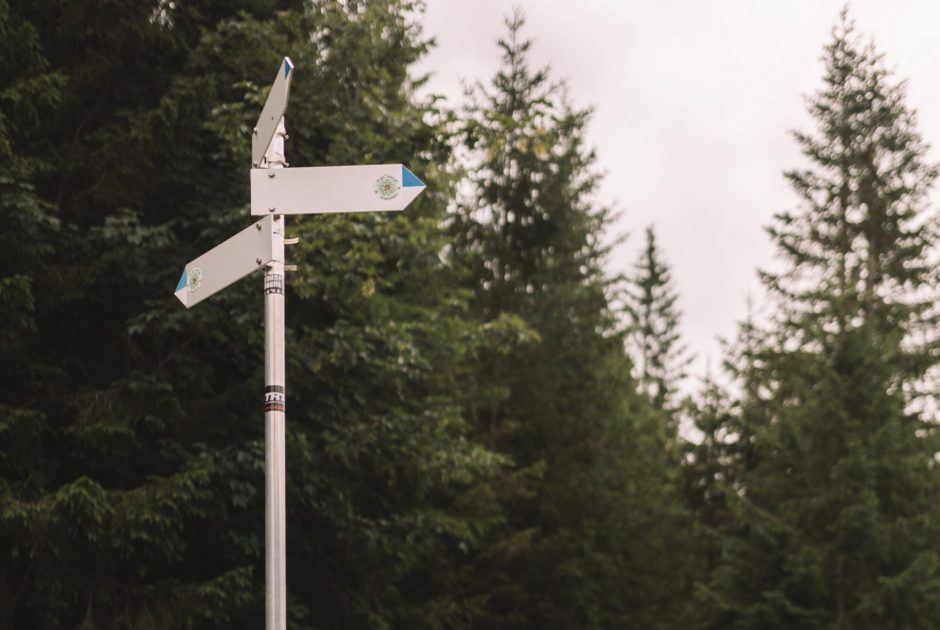
Signs and other pointers constitute the foundation for the safe exploration of the mountains. All the markings for a fictitious hiking trail were heaped into a pile for this piece. Ripped from their context – liberated of meaning and logic – they form abstract fields of colour in the midst of the landscape. The installation aims to question signage and challenge the apparent independence with which we move through our environment.
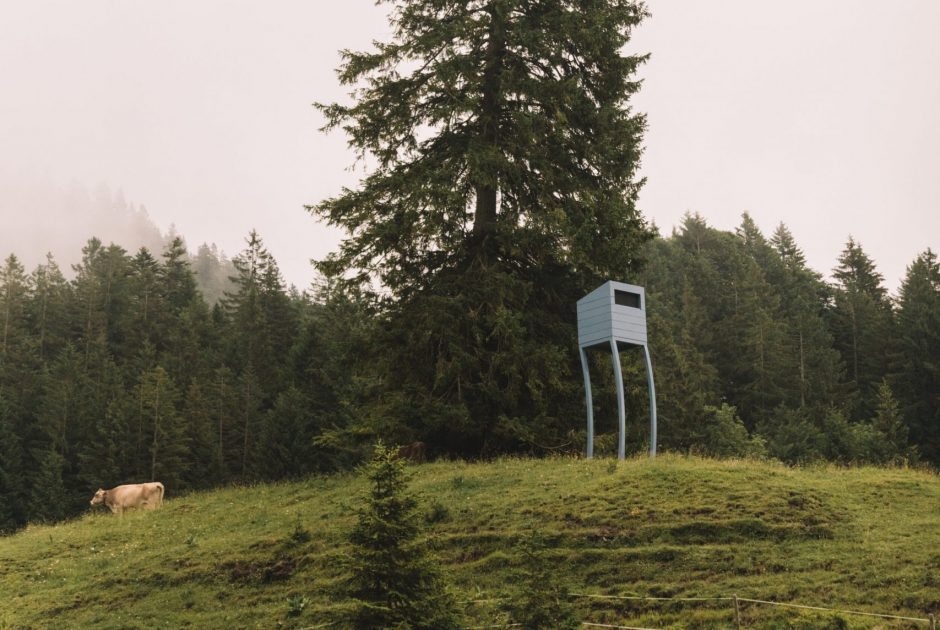
The forest is an encounter with original nature that people usually only want to experience when on holidays and that also often symbolises the unconscious in fairy tales. The protagonists can only develop by entering the forest, by daring to cross the threshold to brute primordial ground and leaving their safe footing behind. An analysis of Marbod Fritsch’s art presents the opportunity for an associative approach. Into the forest, into the unconscious.
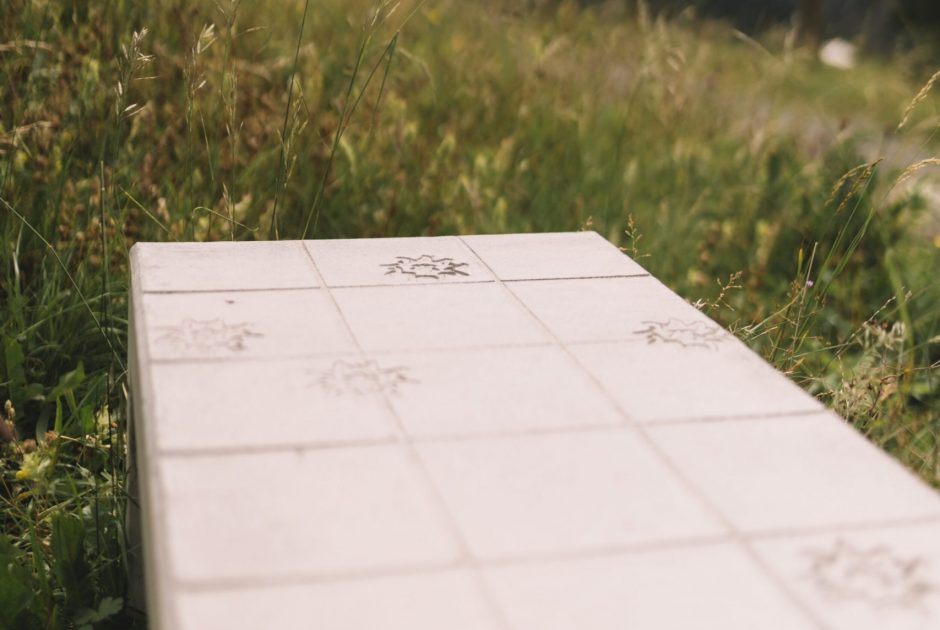
The bench as a minimal intervention into the natural landscape creates the space for reflecting on Marlen Haushofer’s thought.
Edelweiss is an immigrant from Central Asia and a simple decorative element with a complexity that prevents affiliation and therefore simple narratives. It becomes a symbol of alienation, something unreal in the idyllic natural landscape.
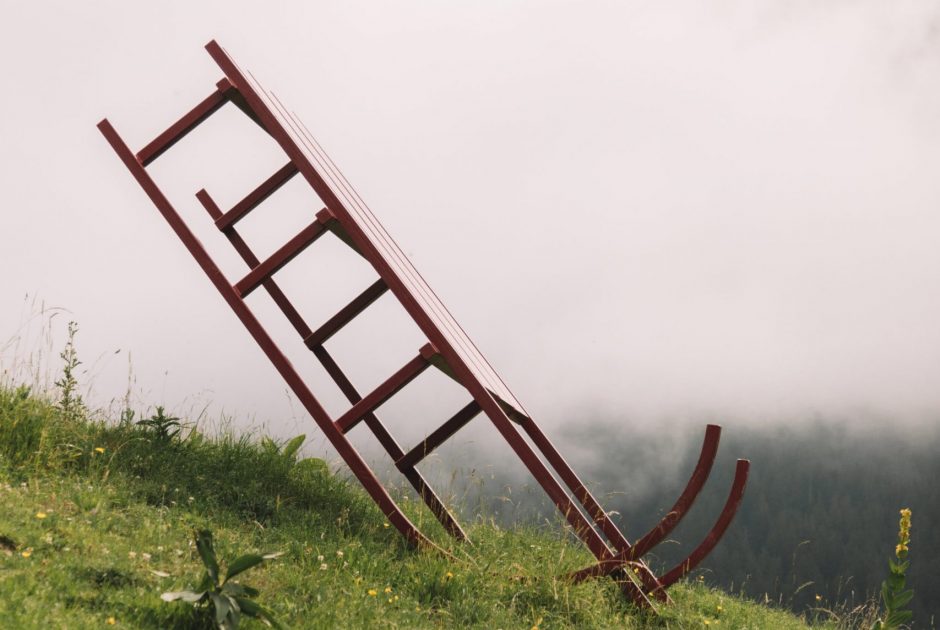
The sledge is reminiscent of a three-dimensional photograph and takes the arduous nature of the farmers’ work as well as the danger associated with transporting hay by sledge, which was common at the time, as its subject.
Frozen in motion, detached from time, the sculpture petrifies a moment of indeterminacy: the rear section is lifting off the ground but it remains open whether the sledge will roll over or find its way back to the slope.
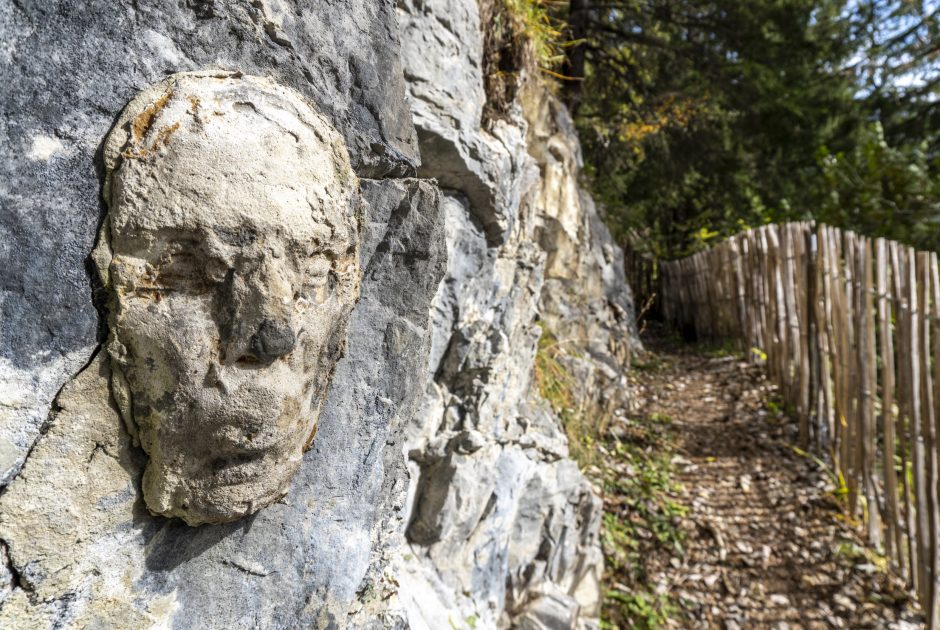
The Muttersberg is an area that was settled a long time ago and where mining was practised in addition to agriculture. A chapel and a school were built and later abandoned. So there are many memories and stories, of the good times and the difficult times, of hard work and the joy of life. Alfred Graf has installed a ‘gallery of heads’ here that is reminiscent of the presidential portraits on Mount Rushmore in the USA – realised in cement-bound material sourced from the Muttersberg.
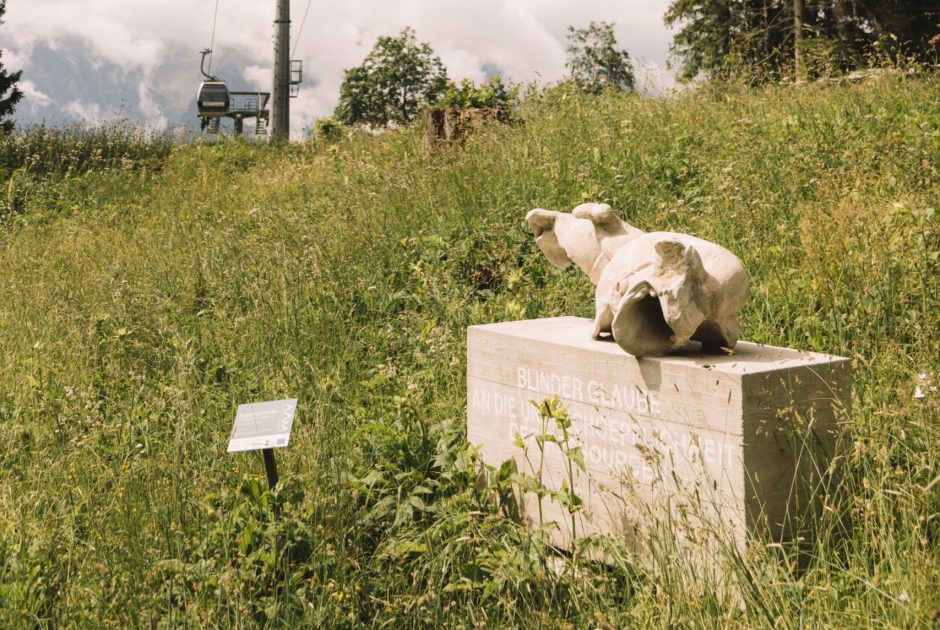
Life came from water. The fish is a symbol of life. A life that is being increasingly endangered on this planet by depriving ourselves of our own resources. Turbo-capitalism, which is plundering nature to an unprecedented degree, will inevitably bring about an ecological catastrophe if there’s no rethinking that manifests itself in appropriate action, in a partnership with nature.
Guided tours on inquiry:
Single Trail Muttersberg
Length: 2,1 km
Altitude difference: 720
Difficulty: demanding